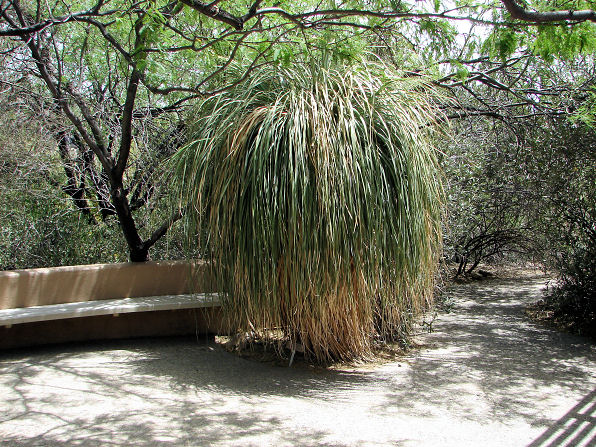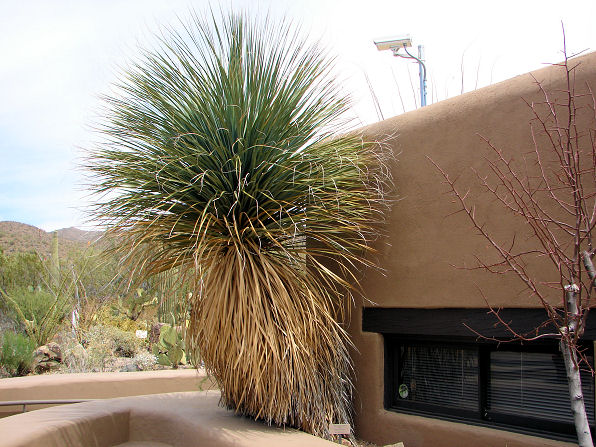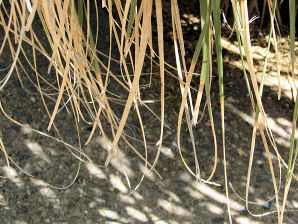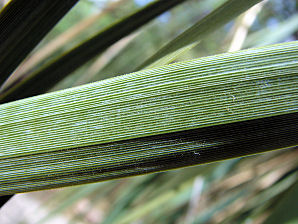Xeriscape Landscape Plants & Flowers
For The Arizona Desert Environment.
Pictures, Photos, Images, Descriptions, & Reviews.
Tree Bear Grass, Nolina matapensis.
We Are Proud Of Our SafeSurf Rating!
Click On Any Of The Following Links By Amazon.Com
For Books, & Videos About Wildflowers Of Arizona & The Southwest USA. No Obligation!
 |
| Tree Bear Grass, Nolina matapensis. Arizona-Sonora Desert Museum. April 19, 2008. |
|---|
 |
| Tree Bear Grass, Nolina matapensis. Arizona-Sonora Desert Museum. April 19, 2008. |
 |  |
| Tree Bear Grass. Leaf Tips. Nolina matapensis. | Tree Bear Grass. Leaf Margins. Nolina matapensis. |
|---|
Tree Bear Grass.
We wish to thank Wikipedia, the free encyclopedia for some of the information on this page. We share images and information with Wikipedia. Originally included within the Agavaceae family, all of the four genera Beaucarnea, Calibanus, Dasylirion, and Nolina are now into their own monocotyledonous family the Nolinaceae. In its native locations, Nolina matapensis is a tall, tree-like plant with a trunk which can reach 10 - 20 feet tall on an average. Some older plants have been found that develop a branching form with 3 or more branches and are over 20 feet tall. Of course, this takes many years as the trunks grow at a rate of about 3 inches per year. This lush-looking species comes with 3 - 5 foot long, one half inch wide, bright green leaves, with a bluish hue. The fluffy inflorescence is a branched panicle about 4 - 6 feet long, with small white flowers, in the summer. The seeds are inside a papery fruit. While the leaves of this accent plant are unarmed, its edges are razor sharp and can inflict cuts. Individual Tree Bear Grass plants grow slowly but they need 5 to 6 feet to spread out, so be careful not to plant them in tight spaces. Also they may realistically reach about 8 feet tall in urban landscapes.
Quick Notes:
Height: 6 to 10 feet, but can be 8 - 10 feet tall with up to a spread of 6 feet; in an urban setting.
Flowers: Its tiny 1/8" long flowers are white on a fluffy inflorescence.
Flowering Time: Phoenix Arizona, June to July.
Seeds: Bean-like seed pods. When the seed pod is fully ripe on the plant, it will split open revealing seeds with beautiful "wings" so that seeds can blow away.
Leaves: Dark green bluish leaves, leathery and sharp margined. Evergreen. narrow, 4 - 6 feet long and 1 inch wide.
Found: Native of the Sonoran desert in Mexico; (Sonora, & Chihuahua). Discovered near Hermosillo, Sonora, Mexico.
Hardiness:
Soil pH requirements:
Sun Exposure:
Elevation: 0 - 4,800 feet in Arizona.
Habitat: It grows well on dry slopes and rocky ridges and in creosote bush scrub.
Miscellaneous: Photos Taken: Arizona-Sonora Desert Museum. April 19, 2008. Plant Is Maintenance: Low. Cold hardy to about 15�F and drought resistant.
|
We Are Proud Of Our SafeSurf Rating!
Click On Any Of The Following Links By Amazon.Com
For Books, & Videos About Wildflowers Of Arizona & The Southwest USA. No Obligation!
| © 1966 - Present, Audrey, Eve, & George DeLange |
